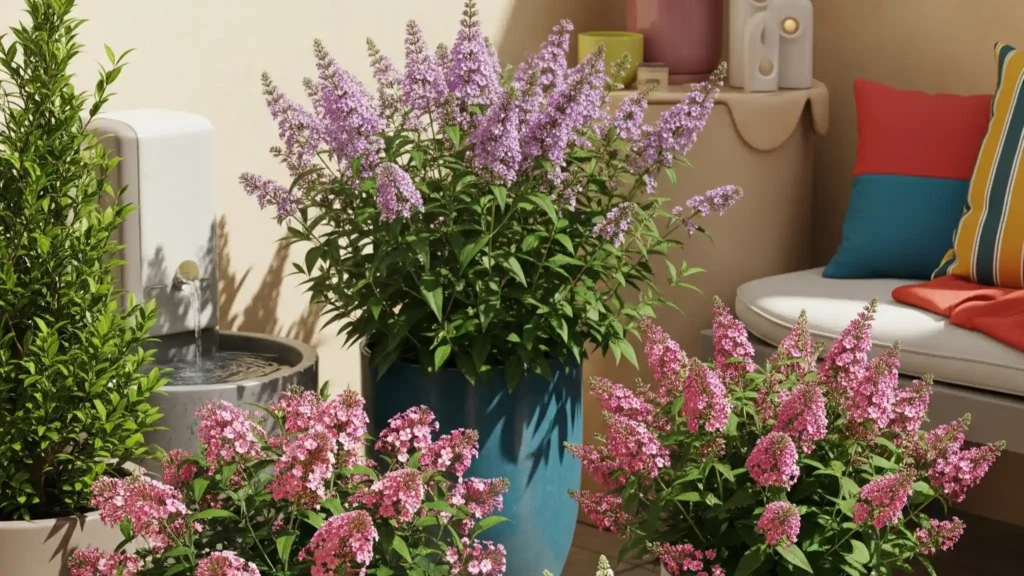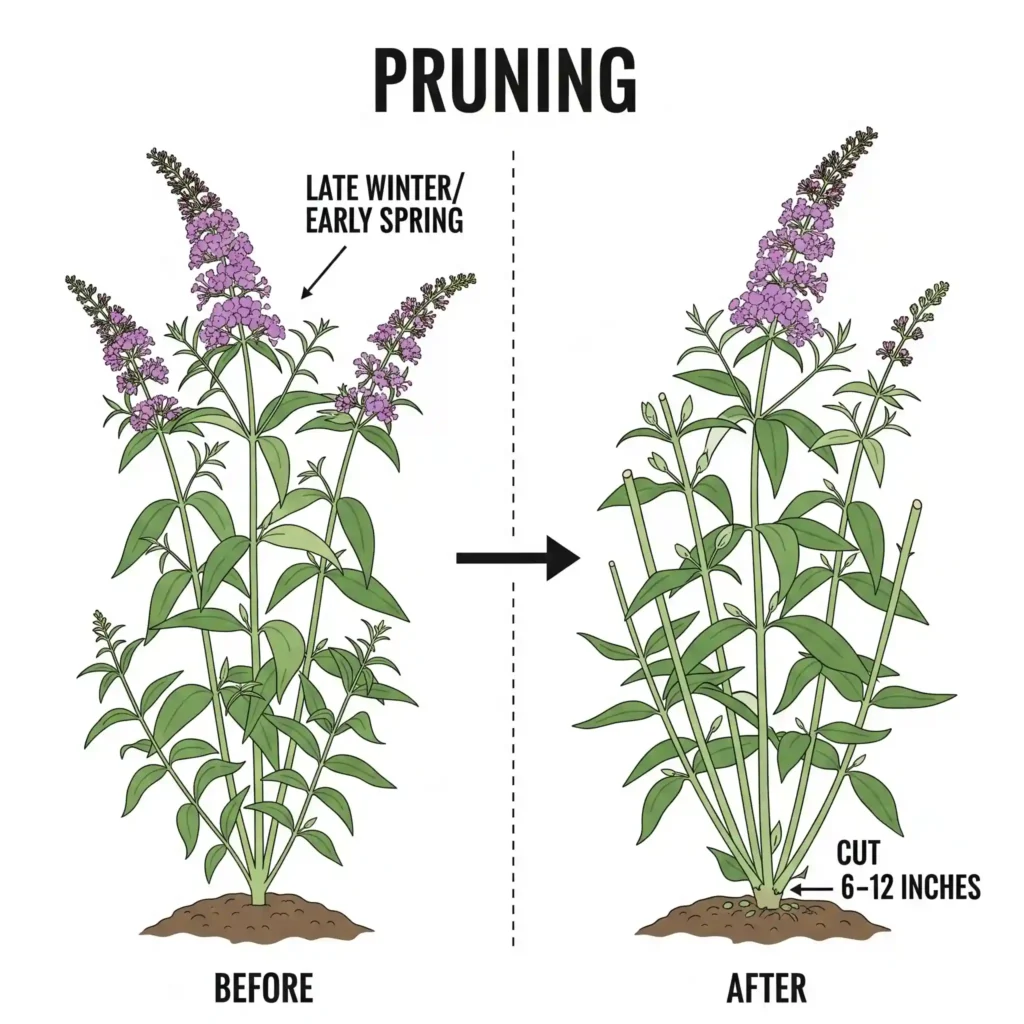Want to Have a Lot of Butterflies in Your Garden? This shrub draws them in like a magnet and blooms till fall.
Have you ever stood in your garden on a quiet summer afternoon and wished for a bit more magic? That soft, fascinating dance of colorful wings is what I’m talking about. It’s the kind of vitality and movement that makes a space feel truly alive. I sought that feeling for years, planting all kinds of flowers in the hopes of attracting our beloved butterflies. Some things helped a little, but nothing could have prepared me for the day I planted my first butterfly bush. There were more than just a few guests; it was a celebration. A full-blown, fluttering party that went on till the first chills of fall.
You’re in the perfect place if you want to feel that same thrill. Don’t bother with hard-to-read gardening books. Buddleja davidii is the one shrub that keeps its promise better than any other. Let’s talk about it as friends. It’s not just about planting a shrub; it’s about making a place to go. A gas station for butterflies that runs on nectar. Let’s get our hands dirty and discover the easy tricks to help this amazing plant grow.
What is a butterfly bush, exactly? It’s a nectar powerhouse.
So, what’s the big deal about this plant? The butterfly bush, or Buddleja davidii, is a fast-growing shrub with a very specific skill at its core. Hundreds of small flowers make up its long, cone-shaped bloom clusters. Imagine that each one is a small, nicely shaped cup full of the nectar that butterflies love. It’s not simply a gorgeous flower; it’s a well-made place to eat.
This isn’t a fragile perennial that you have to take care of all the time. This shrub is strong and woody, and it really wants to expand. Some of the traditional types can grow to be 10 to 15 feet tall, but don’t worry if you have a small garden. Modern gardeners can choose from a wide range of smaller, dwarf types that only grow to be 2 to 3 feet tall.
But this is the most crucial thing you need to know, the key that will open up everything else we talk about: The blossoms on the butterfly bush grow on “new wood.” This just means that the flowers only bloom on the new stems that the plant makes this year. Keep that in mind; it’s the most critical thing you need to do as its caretaker.
Choosing the Right Butterfly Bush for Your Garden and Your Heart
Isn’t it half the battle to pick the appropriate plant from the start? People sometimes make the mistake of falling in love with a pretty “Black Knight” at the nursery, only to find that it has eaten up their whole flowerbed two years later. So, consider the final size before you buy. You really need to seek for the dwarf series like “Pugster” or “Lo & Behold” if you’re planting in a small space or a container.
I have to state that the “Pugster” series is a game-changer based on my own experience. You had to select between a giant plant with big blossoms and a small plant with tiny, sad-looking flowers for years. The “Pugsters” make the plant stay small and give it those enormous, beautiful flower panicles. For a modern garden, it’s really the best of both worlds.

Let’s talk honestly about how invasive it is now. In other regions, including the Pacific Northwest, older kinds of butterfly bush have done too well and are now seen as invasive. They spread by seed and can take over native plants. But don’t worry! This problem has been fixed by plant breeders. It’s easy to find current cultivars that are sterile (they don’t make seeds that can grow). Choose one of the newer, less intrusive kind every time. You’ll be helping your local ecology a lot. You can find out what your local experts suggest by calling your university extension office or a reliable source like the Missouri Botanical Garden.
How to Plant Your Butterfly Bush So It Will Grow Well
You have brought your new plant home. Great! Now, let’s give it the best chance to live a long and happy life. The optimum times to plant are in the spring after the last frost, or in the early fall.
A butterfly shrub needs two things to live: full light and soil that drains well. You might be curious about why. A plant gets its energy from the sun, and making all those blossoms requires a lot of energy. It needs at least six hours of bright, direct sunlight to put on a nice spectacle.
The most important thing about the soil is that it is “well-drained.” These plants are resilient, but they can get root rot, which is their weak point. Their roots will decay if they sit in cold, wet soil. This is the main reason why these plants die. So, how do you plant it the appropriate way?
- Make a hole that is roughly twice as wide as the pot it came in, but not deeper. We want the roots to spread out, not down into the wet ground.
- Gently pull the plant out of its pot. If you detect roots going around the bottom, use your fingers to gently pull them apart. This informs them, “You’re free! Go out and see!”
- Put your new shrub in the hole, making sure that the top of the root ball is level with the earth surrounding it. Many shrubs die if you plant them too deep.
- Put the dirt you dug out back in the hole. Don’t waste your time putting a lot of sophisticated compost or fertilizer in the hole. You want the roots to grow out into the natural soil, not just stay in a comfortable, changed pocket.
- Give it a lengthy glass of water to settle everything down and get rid of any air pockets.
The Secret to Never-Ending Flowers: Water, Food, and a Trick
It’s surprisingly easy to make your plant happy after it’s in the ground. There are really only three things that matter.
First, water.
Once a week or so, give it a deep drink, especially if it’s hot. What happens next? You can pretty much forget about it unless you’re in a really bad drought. Once these plants are established, they are resilient and don’t need much water.
Second, food.
Here’s a secret: butterfly bushes blossom best when you don’t take care of them too much. I know it sounds insane! But if you give them a lot of rich fertilizer, they’ll repay you by developing a lot of green foliage and not many blossoms. In the spring, all you have to do is scratch some compost into the ground around the base. That’s all. Really.
The third step, which is the trick, is to deadhead.
You need to cut off a flower spike as soon as it starts to look brown and faded. Why? The plant’s only job is to create seeds. When you chop off the old blossom, it can’t make seeds anymore. The plant is scared and thinks, “Oh no! I haven’t finished my life’s work!” it says, and right away it starts creating new blooms.
From what I’ve seen, this is the one task that pays off the most. Every few days, I’ll go out into the garden with my coffee and cut, cut, cut. It only takes five minutes, and it easily doubles the number of flowers I get. It’s the difference between a plant that blooms and one that puts on a show that lasts all summer long.
How to Cut Back Your Butterfly Bush (Don’t Be Afraid!)
Okay, take a deep breath. We’re going to talk about the most crucial and, for a lot of folks, the scariest part of having a butterfly bush: cutting it down. Do you remember us saying that it only blooms on new wood? This is where that becomes really important. Every year, you have to cut back a bush really hard to get it to bloom all the way down.
If you don’t, you’ll get a large, woody, twisted beast with a few sad little flowers at the top. It won’t look good.
The timing is key. You have to wait until late winter or very early spring. You’re looking for the time when you can see tiny fresh leaf buds starting to grow on the old, woody stems. That’s your sign. Don’t cut it back in the fall, no matter what. If you cut the stems, water can get in, freeze, and break the whole base of the plant, destroying it.
So, when the moment is right, get a sharp set of loppers and be daring.
- Cut back all of the woody stems so that they are about 6 to 12 inches above the ground. Yes, the whole thing. It will look like a forlorn little pile of sticks.
- While you’re there, get rid of any branches that are fully dead or look weak and thin.
I know it hurts. It doesn’t feel right. The first time I tried it, I thought I had killed my beautiful shrub. But believe me and the science: you’re not killing it. You are making it new again. This severe reset makes the plant grow a lot of new stems that are strong and healthy. Each one of those stems will be covered in lovely flowers that attract butterflies. Experts at sites like the Penn State Extension will tell you that this yearly regeneration is the most important thing for a plant to be healthy and beautiful.
In Conclusion
You see? In the end, it’s not that hard. It’s really easy to make a garden that is full of life. Give your butterfly bush a place in the sun, soil that lets its roots breathe, and the daring “haircut” it requires every spring. If you can master those five things, you’ll get a show that feels like pure enchantment all season long. You didn’t just plant a shrub; you made it possible for nature to dance straight into your backyard.
Questions and Answers
Why are the leaves on my butterfly bush becoming yellow?
When the leaves turn yellow, it usually means its feet are too damp. If your soil is wet, you are watering too much or the drainage is bad. It can also mean that it needs a little nitrogen, but you should always check the soil first to see whether it’s too wet.
Is it possible to cultivate a butterfly bush in a pot?
Yes, for sure, and they look great! Just make sure you pick one of the dwarf types that were bred to be little. Choose a huge pot with numerous of holes for drainage so that the roots can stay healthy.
Do deer eat my butterfly bush?
Not likely! Everyone knows that Buddleja doesn’t attract deer. Even though a hungry deer might eat anything, they usually don’t like butterfly bushes.
What did I do wrong that my butterfly bush isn’t blooming?
Let’s be detectives! The common reasons are: 1) Not enough light (is it getting 6 hours or more?); 2) You didn’t prune it in the spring; or 3) You gave it too much fertilizer (remember, they want to be lean!). One of those is generally always the problem.

How long does it take for a butterfly bush to grow?
In its first year, it will grow a lot. In the second or third year, it will be a fully grown, strong, and mature flowering machine!
Written by a professional gardener who has been doing it for 25 years and is very interested in plant biology. Known for giving clear, science-based recommendations based on a lot of real-world experience.

